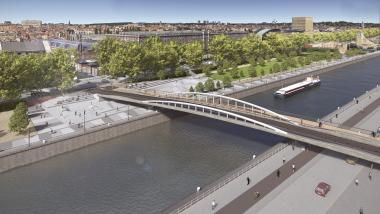
2019.09.02 - Beliris, the specialist federal civil engineering agency for Brussels, starts work on 2 September on the construction of Suzan Daniel Bridge, which will link Boulevard Simon Bolivar to Avenue du Port at its junction with Rue Picard. Designed for public transport, cyclists and pedestrians, it will span the Charleroi-Brussels-Antwerp Canal, with a total length of 90 m. This missing link between the Gare du Nord and Tour & Taxis will offer users a new view of the Canal and the park to be created on Quai des Matériaux.
A new mobility tool
The bridge marks a first in Brussels in being entirely devoted to active mobility: public transport, pedestrians and cyclists will be able to cross it alongside one another in harmony. It will also restore the link between developing districts and zones. Built in partnership with Brussels Mobility, Brussels Environment and the Port of Brussels, the bridge will also give direct access to the park at Quai des Matériaux, which is scheduled for redevelopment by Beliris in the near future.
A technical challenge
The bridge will have a main span of 60 m over the Canal and two lateral spans of 30 m over the docks. The bridge’s concrete deck will be suspended from two strikingly slender metal arches. The main span’s arches and suspender cables will be made of metal and painted white, while the arches of the lateral spans will be made of grey concrete. With a view to the bridge’s construction, an access ramp has already been built between Quai des Péniches and Quai de Willebroeck.
Space for everyone
The bridge will include two traffic lanes: a 7 m hard-surfaced lane for public transport and a 6 m wide timber-clad pedestrian and cyclist lane. From the top of the bridge, cyclists and walkers will have an unobstructed view over the Canal and the future park. For the convenience of people with reduced mobility and cyclists, the bridge's gradient has been restricted to less than 4% over its entire length. The bridge will have a clearance height of 7 m across the width of the Canal to allow barges carrying containers to pass under it. The clearance height over Quai des Péniches will be 4 m to ensure access for the emergency services.
Natural lighting
Large numbers of skylights in the deck, protected by grating, will allow natural light to reach the docks under the bridge. LED lamps on the guardrails will provide functional lighting at night. Architectural lighting, designed in accordance with the City of Brussels lighting plan, will highlight the arches and suspender cables and the piers under the bridge’s deck.
Schedule and budget
Work on the bridge will start on 2 September and end in the spring of 2021. Work on the park at Quai des Matériaux will start in mid-2020. These projects form an impressive example of urban development in Brussels’ Canal Area. The sum of 6.75 million euros has been allocated to this project, which is being implemented by the Beliris teams with project designers Greisch and contractor Jan de Nul - Aelterman.
A new name: Suzan Daniel
The choice of name for the bridge was the subject of a participatory process in which citizens were able to put forward ideas and choose from five shortlisted proposals. The name of Suzan Daniel received the most votes. Born in Brussels in 1918, Suzan Daniel was an habituée of the gay scene in Brussels from a young age, becoming a leading figure in it. In 1953, she attended a conference on sexual equality in Amsterdam. On her return, inspired with a new resolve, she created Belgium’s first LGBT+ movement. She died in Uccle in 2007.
















